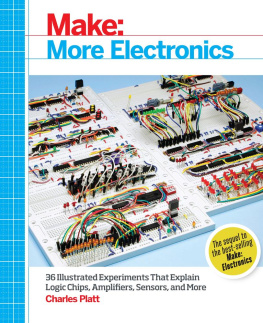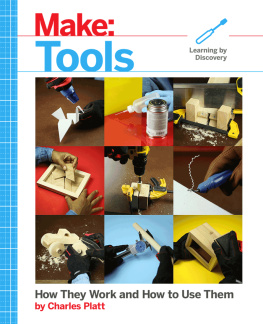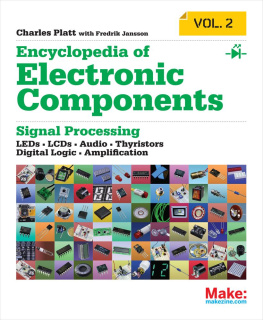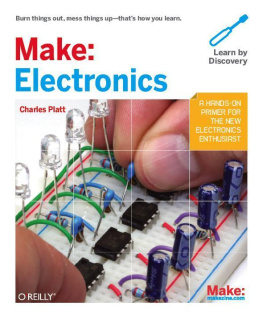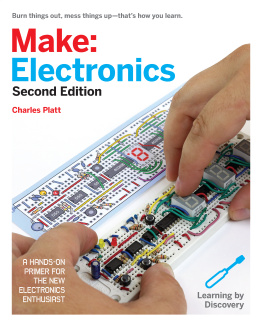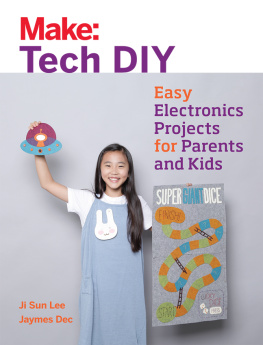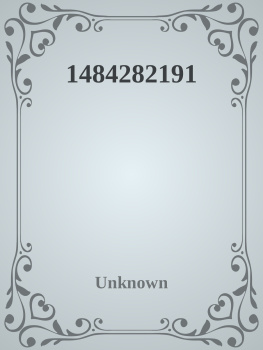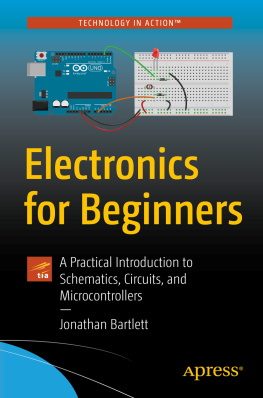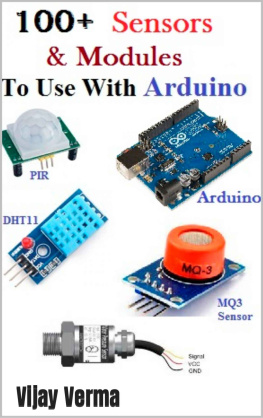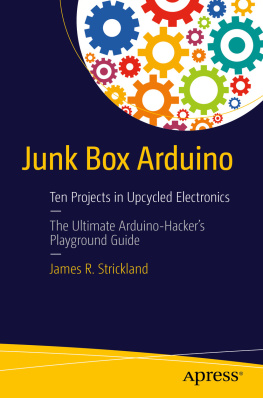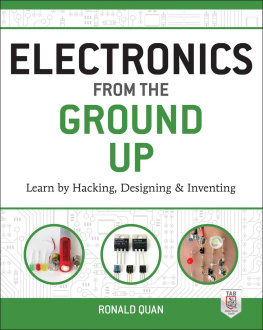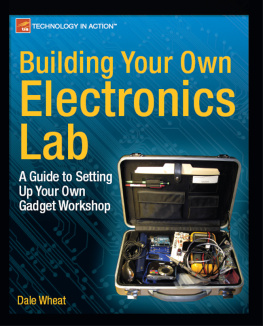Make: More Electronics
Charles Platt
Dedication
In memory of my father, Maurice Platt, who showed me that it is a fine and valuable occupation to be an engineer.
Acknowledgments
I discovered electronics when I was a teenager, in collaboration with my friends in high school. We were nerds before the word existed. Patrick Fagg, Hugh Levinson, Graham Rogers, and John Witty showed me some of the possibilities. Fifty years later, Graham kindly contributed a schematic to this book.
Several decades after that, Mark Frauenfelder nudged me back into the habit of making things. Gareth Branwyn facilitated Make: Electronics, and Brian Jepson enabled its sequel. They are three of the best editors I have known, and they are also three of my favorite people. Most writers are not so fortunate.
I am also grateful to Dale Dougherty for starting something that I never imagined could become so important, and for welcoming me as a participant.
Fredrik Jansson provided advice and corrections while I was working on this project. His patience and good humor have been very valuable to me.
Fact checking was also provided by Philipp Marek. Dont blame Philipp or Fredrik if there are still any errors in this book. Remember that its much easier for me to make an error than it is for someone else to find it.
Circuits were built and tested by Frank Teng and A. Golin. I appreciate their help. I am also grateful for the conscientious attention of Kara Ebrahim and Kristen Brown in the production department, and proofreader Amanda Kersey.
Preface
This book picks up where my previous introductory guide, Make: Electronics , left off. Here you will find topics that I did not explore in detail before, and other topics that were not covered at all because I lacked sufficient space. You will also find that I go a little bit further into technicalities, to enable a deeper understanding of the concepts. At the same time, I have tried to make Learning by Discovery as much fun as possible.
A few of the ideas here have been discussed previously in Make magazine, in very different forms. I always enjoy writing my regular column for Make , but the magazine format imposes strict limits on the wordage and the number of illustrations. I can provide much more comprehensive coverage in this book.
I have chosen not to deal with microcontrollers in much depth, because explaining their setup and programming language(s) in sufficient detail would require too much space. Other books already explain the various microcontroller chip families. I will suggest ways in which you can rebuild or simplify the projects here by using a microcontroller, but I will leave you to pursue this further on your own.
What You Need
Prior knowledge You need a basic understanding of the topics that I covered in the previous book. These include voltage, current, resistance, and Ohms law; capacitors, switches, transistors, and timers; soldering and breadboarding; and a beginners knowledge of logic gates. Of course, you can also learn these topics from other introductory guides. Generally I assume that you have read
Make: Electronics or a similar book, and you have a general memory of it, although you may have forgotten some specifics. Therefore I will include a few quick reminders without repeating the general principles to any significant extent. Tools
Im assuming you already own the following equipment, all of which was described in Make: Electronics :
- Multimeter
- 24-gauge multicolored hookup wire (25 feet of each color, in at least four colors)
- Wire strippers
- Pliers
- Soldering iron and solder
- Breadboard (the preferred type is described in the next section of the book.)
- 9V battery, or an AC adapter (with a DC output) that can deliver between 9VDC and 12VDC at 1A
Components I have listed the components that you will need to build the projects. See . That section also recommends sources for mail-order. Datasheets I discussed datasheets in
Make: Electronics , but I cant overemphasize how important they are. Please try to make a habit of checking them before you use a component that you havent encountered before.
If you use any general search engine to find a part number, most likely youll see half a dozen sites offering to show you the datasheet. These sites are organized for their profit, not for your convenience. You will probably end up clicking repeatedly to see each individual page of the datasheet, because the site owner wants to show you as many ads as possible.
Youll save a lot of time by searching for the part number on the site of a supplier such as http://www.mouser.com, at which point you will be able to click an icon to open the entire datasheet as a multipage PDF document. This will be easier to view and print.
How to Use This Book
There are a few differences in style and organization between this book and the previous one. Also, you need to know how to read the arithmetical notation that I have used.
Schematics
for clarification.
Figure 1. Top: In all the schematics in this book, conductors that make an electrical connection are joined with a black dot. However, the configuration at far right is avoided because it looks too similar to a crossover where there is no connection. Bottom: Conductors that cross one another without making a connection were shown in the style at left in Make: Electronics . The style at right is more common, and is used in this book.
Also in Make: Electronics I used the European convention for eliminating decimal points in component values. Thus, values such as 3.3K and 4.7K were expressed as 3K3 and 4K7. I still prefer this style, because decimal points can become hard to discern in a poorly printed schematic. However, some readers were confused by the European notation, so I have discontinued it in this book.
Dimensions
Integrated circuit chips (and many other parts) all used to be equipped with wire legs, properly known as leads, for insertion into holes in circuit boards. The leads on these through-hole components were spaced at intervals of 0.1, and the components were reasonably easy to grasp and position with just your finger and thumb.
This idyllic vision of universal compatibility on a human scale was disrupted initially by an invasion from the metric system. Some manufacturers moved from a pin spacing of 2.54mm (the equivalent of 0.1) to 2mm as the standard, causing frustration for those of us using 0.1 perforated board. Millimeters popped up in other places, too. To take just one example, that most ubiquitous part, the panel-mounted LED, is often 5mm in diameter. This is a fraction too big for a 3/16 hole, but not quite big enough to fit tightly in a 13/64 hole.
Because this book is written and published in the United States, I generally use inches by preference. You will find a conversion table between millimeters and fractions of an inch in Make:Electronics .
A much more significant problem is that the entire electronics industry has moved toward surface-mount formats. Instead of a 0.1 pin spacing, there are no pins at all, and a whole component is typically no longer than 0.1. To build a circuit from these parts, you really need tweezers, a microscope, and a special soldering iron. It can be done, but personally I dont find it enjoyable, and you will not find any projects in this book that use surface-mount components.

